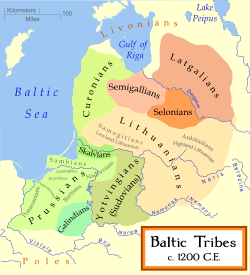
Back Дайнава (рэгіён) Byelorussian Sudauen German Sudovio Esperanto Dainava (baltų žemė) Lithuanian Sudava (zeme) Latvian/Lettish Sudovië Dutch Jaćwież Polish Ятвягия Russian Ятвягія Ukrainian
Yotvingia Sūdava Dainava | |||||||||||
|---|---|---|---|---|---|---|---|---|---|---|---|
| 7th century–1442 | |||||||||||
 Baltic Tribes in 12th century, Yotvingian territory marked in darker green. | |||||||||||
| Capital | Skomandburg (c. 1260-1281) | ||||||||||
| Government | |||||||||||
• King | Netimeras (c. 980) | ||||||||||
• Duke (kuningas) | Komantas (c. 1260-1281) Kantigirdas (c. 1283) | ||||||||||
| Historical era | Middle Ages | ||||||||||
• Established | 7th century | ||||||||||
• Disestablished | 1442 | ||||||||||
| |||||||||||
54°30′N 23°00′E / 54.500°N 23.000°E

Yotvingia or Sudovia (Yotvingian: Sūdava, Lithuanian: Dainava, Polish: Jaćwież, German: Sudauen, Eastern Slavic: Яцьвезь (Ятвязь, Етвязь), Ятвягия) was a region where the Baltic tribe known as Yotvingians lived. It was located in the area of Sudovia and Dainava; south west from the upper Nemunas, between Marijampolė, Merkinė (Lithuania), Slonim, Kobryn (Belarus), Białystok, and Ełk (Poland).
Today this area corresponds mostly to the Podlaskie Voivodeship of Poland, part of Lithuania and a part of Hrodna Province and Brest Province of Belarus.